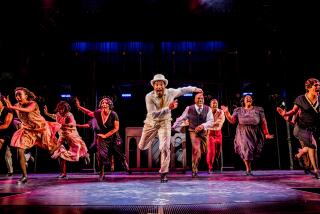From ‘Hat’ to Tails, Fred Astaire Is Tops
- Share via
Did American dance begin with Fred Astaire? Of course not, it just seems that way.
Few high-steppers have been lionized like Astaire. Through the movies, he became the populist image of what dancing was all about. His glides, leaps and taps informed people, made it accessible. Credit the talents of Astaire and the influence of film.
As anyone who knows anything about anything can tell you, he deserved all the praise. Nobody in the pictures (not even the athletic Gene Kelly, who managed a good-humored rivalry with Astaire for years) was in his class.
Personally, I prefer Astaire solo, doing his own thing without the restraints imposed by a partner. Astaire alone was a dancer who consciously laid traps and puzzles into his routines, then cleverly, happily danced out of them. Astaire created the feeling of freedom every time he moved over the floorboards, up the walls or across the ceiling, as he did in a famous sequence in “Royal Wedding” in 1951.
But his fame really began in the ‘30s in a series of musicals with Ginger Rogers. There were nine in all (every one for RKO, beginning with “Flying Down to Rio” in 1933 and ending with “The Story of Vernon and Irene Castle” in 1939). Perhaps the best, 1935’s “Top Hat,” opens a three-film series on musicals Friday night at the Newport Harbor Art Museum.
As usual, the plot doesn’t amount to much. Astaire plays Jerry Travers, a carefree entertainer who meets Dale Tremont (Rogers) after his lively tap-dance wakes her in the hotel suite below his. She’s suspicious of Jerry’s smooth ways but eventually falls for his cool singing and cooler dancing. Whenever Dale starts to stray, Jerry just starts the footwork; he hypnotizes her like a cobra in a basket.
The story takes a comic, mistaken-identity turn when Dale believes Jerry is actually Horace (Edward Everett Horton), the husband of her good friend Madge (Helen Broderick). Thinking Jerry is a philandering jerk, her love fizzles. But there’s a spark still there, and Jerry spends the rest of the movie trying to rekindle it.
Director Mark Sandrich is smart enough to know that Astaire’s dancing is the best way for Jerry to win Dale back. In between the semi-funny slippings and slidings of the plot are a handful of memorable dance routines, reaching an apex with the well-known “Cheek to Cheek” sequence near the movie’s end. Rogers is no Astaire, but she keeps up smartly enough, even in those tall heels.
The elegance of that number is clear, but a more inventive set-piece comes much earlier, sans Rogers. Dancing and singing “Top Hat, White Tie and Tails” (one of picture’s many fine Irving Berlin tunes), Astaire systematically “guns down” his chorus of male dancers, using a staccato of tap steps to waste them against an Art Deco backdrop. The scene is at once both lighthearted and moody.
The series continues July 29 with “42nd Street” (1933) and ends Aug. 5 with “Singin’ in the Rain” (1952). Arthur Taussig, an Orange Coast film instructor and author of The Film Analyst newsletter, will discuss the films before and after their screenings.
* What: “Top Hat.”
* When: Friday, July 22, at 6:30 p.m.
* Where: The Newport Harbor Art Museum, 850 San Clemente Drive, Newport Beach.
* Whereabouts: Take Pacific Coast Highway to Jamboree Road and head north to Santa Barbara Drive and then east to San Clemente Drive.
* Wherewithal: $3 for museum members, seniors and students; $5 for the public.
* Where to call: (714) 759-1122.
More to Read
The biggest entertainment stories
Get our big stories about Hollywood, film, television, music, arts, culture and more right in your inbox as soon as they publish.
You may occasionally receive promotional content from the Los Angeles Times.










